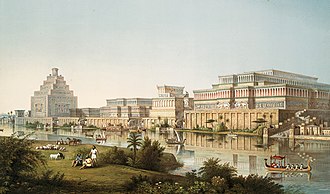Nineveh







Nineveh was an ancient Assyrian city located on the eastern bank of the Tigris River, and it was the capital of the Neo-Assyrian Empire. It is situated in modern-day Mosul, in Iraq. Nineveh was one of the most important cities in antiquity and played a significant role in the history of the Ancient Near East.
History[edit]
Nineveh's history dates back to the 7th millennium BCE. It became a major city under the rule of the Assyrian Empire, particularly during the reign of Sennacherib, who made it the empire's capital in the early 7th century BCE. The city was known for its impressive architecture, including the famous city walls and the Palace of Sennacherib.
Assyrian Empire[edit]
The Assyrian Empire was a major Mesopotamian kingdom and empire of the ancient Near East and the Levant. Nineveh served as its capital during the empire's peak. The city was a center of commerce, religion, and governance.
Destruction[edit]
Nineveh fell to a coalition of Babylonians, Medes, and Scythians in 612 BCE. The city's destruction marked the end of the Assyrian Empire. The ruins of Nineveh were later excavated in the 19th century, revealing much about Assyrian culture and history.
Archaeology[edit]
The site of Nineveh has been extensively excavated, revealing a wealth of artifacts and information about the Assyrian Empire. Notable discoveries include the Library of Ashurbanipal, which contained thousands of clay tablets with cuneiform script.
Cultural Significance[edit]
Nineveh is mentioned in various ancient texts, including the Bible, where it is described as a "great city." It is also referenced in the Epic of Gilgamesh and other Mesopotamian literature.
Related Pages[edit]
- Assyrian Empire
- Sennacherib
- Library of Ashurbanipal
- Mosul
- Tigris River
- Ancient Near East
- Babylonians
- Medes
- Scythians
Categories[edit]

This article is a Ancient Near East–related stub. You can help WikiMD by expanding it!
Ad. Transform your life with W8MD's Budget GLP-1 injections from $75


W8MD offers a medical weight loss program to lose weight in Philadelphia. Our physician-supervised medical weight loss provides:
- Weight loss injections in NYC (generic and brand names):
- Zepbound / Mounjaro, Wegovy / Ozempic, Saxenda
- Most insurances accepted or discounted self-pay rates. We will obtain insurance prior authorizations if needed.
- Generic GLP1 weight loss injections from $75 for the starting dose.
- Also offer prescription weight loss medications including Phentermine, Qsymia, Diethylpropion, Contrave etc.
NYC weight loss doctor appointmentsNYC weight loss doctor appointments
Start your NYC weight loss journey today at our NYC medical weight loss and Philadelphia medical weight loss clinics.
- Call 718-946-5500 to lose weight in NYC or for medical weight loss in Philadelphia 215-676-2334.
- Tags:NYC medical weight loss, Philadelphia lose weight Zepbound NYC, Budget GLP1 weight loss injections, Wegovy Philadelphia, Wegovy NYC, Philadelphia medical weight loss, Brookly weight loss and Wegovy NYC
|
WikiMD's Wellness Encyclopedia |
| Let Food Be Thy Medicine Medicine Thy Food - Hippocrates |
Medical Disclaimer: WikiMD is not a substitute for professional medical advice. The information on WikiMD is provided as an information resource only, may be incorrect, outdated or misleading, and is not to be used or relied on for any diagnostic or treatment purposes. Please consult your health care provider before making any healthcare decisions or for guidance about a specific medical condition. WikiMD expressly disclaims responsibility, and shall have no liability, for any damages, loss, injury, or liability whatsoever suffered as a result of your reliance on the information contained in this site. By visiting this site you agree to the foregoing terms and conditions, which may from time to time be changed or supplemented by WikiMD. If you do not agree to the foregoing terms and conditions, you should not enter or use this site. See full disclaimer.
Credits:Most images are courtesy of Wikimedia commons, and templates, categories Wikipedia, licensed under CC BY SA or similar.
Translate this page: - East Asian
中文,
日本,
한국어,
South Asian
हिन्दी,
தமிழ்,
తెలుగు,
Urdu,
ಕನ್ನಡ,
Southeast Asian
Indonesian,
Vietnamese,
Thai,
မြန်မာဘာသာ,
বাংলা
European
español,
Deutsch,
français,
Greek,
português do Brasil,
polski,
română,
русский,
Nederlands,
norsk,
svenska,
suomi,
Italian
Middle Eastern & African
عربى,
Turkish,
Persian,
Hebrew,
Afrikaans,
isiZulu,
Kiswahili,
Other
Bulgarian,
Hungarian,
Czech,
Swedish,
മലയാളം,
मराठी,
ਪੰਜਾਬੀ,
ગુજરાતી,
Portuguese,
Ukrainian